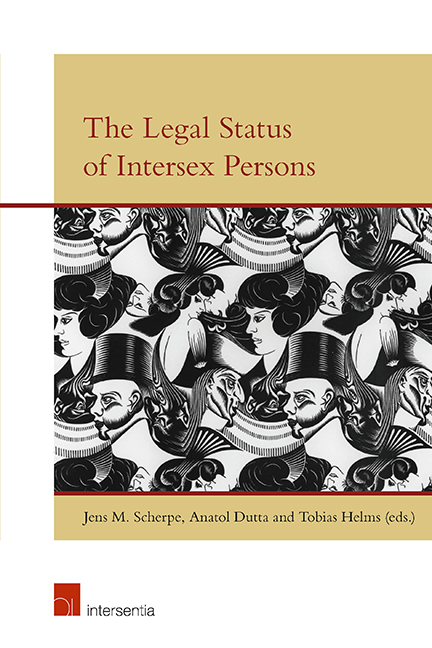Book contents
- Frontmatter
- Preface
- Contents
- List of Contributors
- The Legal Status of Intersex Persons: An Introduction
- Malta Declaration
- Darlington Statement
- Vienna Statement
- PART I MEDICINE AND PSYCHOLOGY
- PART II THEOLOGY AND LEGAL HISTORY
- PART III TRANSGENDER, TRANSSEXUALITY AND INTERSEX
- PART IV NATIONAL LEGAL DEVELOPMENTS
- Australia
- Sweden
- India
- The Netherlands
- France
- Colombia (The Colombian Constitutional Court)
- United States
- Malta
- Germany (The 2013 German Law)
- Germany (German Inter-Ministerial Working Group)
- Germany (Gender Diversity in Law)
- PART V PRIVATE INTERNATIONAL LAW ASPECTS OF INTERSEX
- PART VI INTERSEX AND HUMAN RIGHTS
Colombia (The Colombian Constitutional Court)
from PART IV - NATIONAL LEGAL DEVELOPMENTS
Published online by Cambridge University Press: 31 January 2019
- Frontmatter
- Preface
- Contents
- List of Contributors
- The Legal Status of Intersex Persons: An Introduction
- Malta Declaration
- Darlington Statement
- Vienna Statement
- PART I MEDICINE AND PSYCHOLOGY
- PART II THEOLOGY AND LEGAL HISTORY
- PART III TRANSGENDER, TRANSSEXUALITY AND INTERSEX
- PART IV NATIONAL LEGAL DEVELOPMENTS
- Australia
- Sweden
- India
- The Netherlands
- France
- Colombia (The Colombian Constitutional Court)
- United States
- Malta
- Germany (The 2013 German Law)
- Germany (German Inter-Ministerial Working Group)
- Germany (Gender Diversity in Law)
- PART V PRIVATE INTERNATIONAL LAW ASPECTS OF INTERSEX
- PART VI INTERSEX AND HUMAN RIGHTS
Summary
INTRODUCTION
Often ignored by the law, intersexuality has been the subject of numerous decisions by the Colombian Constitutional Court. For more than 20 years now, this court has discussed the issue of sexual diversity, producing a consistent legal framework for practitioners, activists and intersex people. Such a framework, interestingly, was developed through the interpretation of general constitutional provisions – such as those aimed at protecting dignity (Article 1 Constitución Politica, henceforth CP), the free development of the personality (Article 16 CP) and the right to equality (Article 13 CP). Moreover, the Constitutional Court has demonstrated a significant will to engage with a difficult area of law from an interdisciplinary angle, relying not only on traditional medical sources, but also on critical theory and activists ‘insights.
To set the Court's activity in context, we must recall that the model of medicalisation applied to intersexuality, as we know it today and as it has come to be gradually – de facto – challenged by the Colombian Constitutional Court, was developed in the mid-1950s in the United States, essentially under the scientific direction of the psychologist Dr. John Money and his team. According to him, what we now call gender identity seemed to be independent from physical characteristics and be the result of different stimuli, including education and social models, which influenced the development of the individual at the early stages of life. Among these stimuli, genitals were given a paramount importance. In Money's understanding, any conflict among the stimuli – primarily, genitalia deviating from established standards of maleness and femaleness (henceforth, non-normative or diverse) – could trigger misalignments with the attributed social gender – what one may call now a ‘trans condition’ – which was perceived as a risk to psychological health. Normalisation – so to say – of non-normative genitalia was thus prescribed. After the initial gender assignment based on the interpretation of biological markers, came surgical and hormonal therapies, aimed at giving a more usual look to the intersex anatomy. Additionally, practical considerations also played a determinant role in gender assignment – especially with biological males – in consideration of the technical limitations to phallus reconstruction. Boys for whom masculinisation was not a viable option would be reassigned to the feminine gender and subject to consistent treatments.
- Type
- Chapter
- Information
- The Legal Status of Intersex Persons , pp. 319 - 338Publisher: IntersentiaPrint publication year: 2018
- 1
- Cited by

